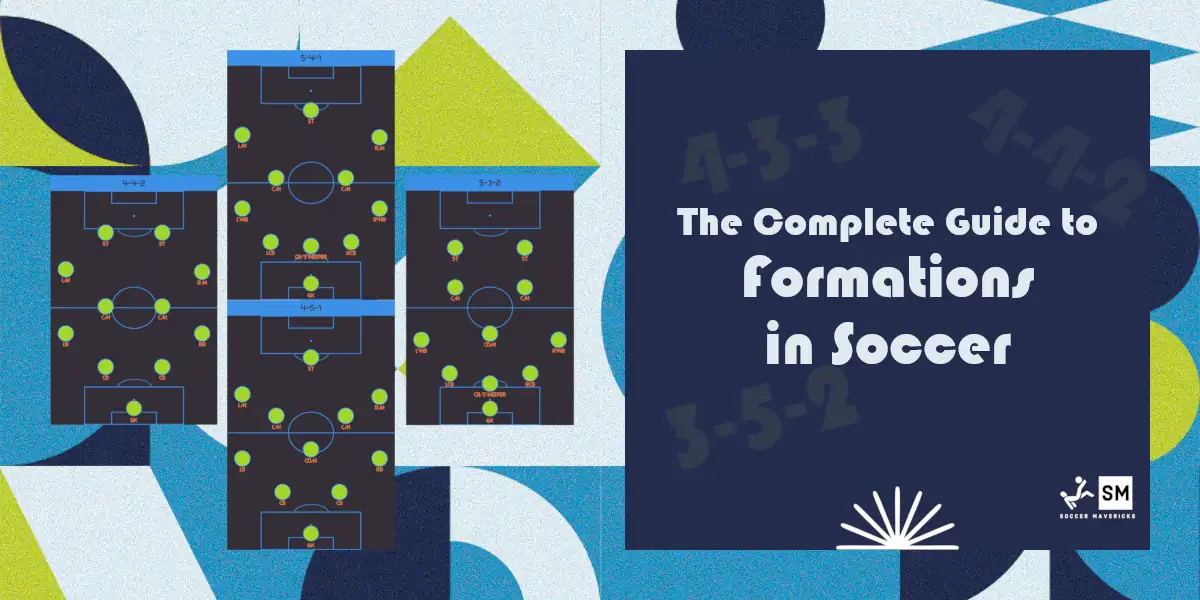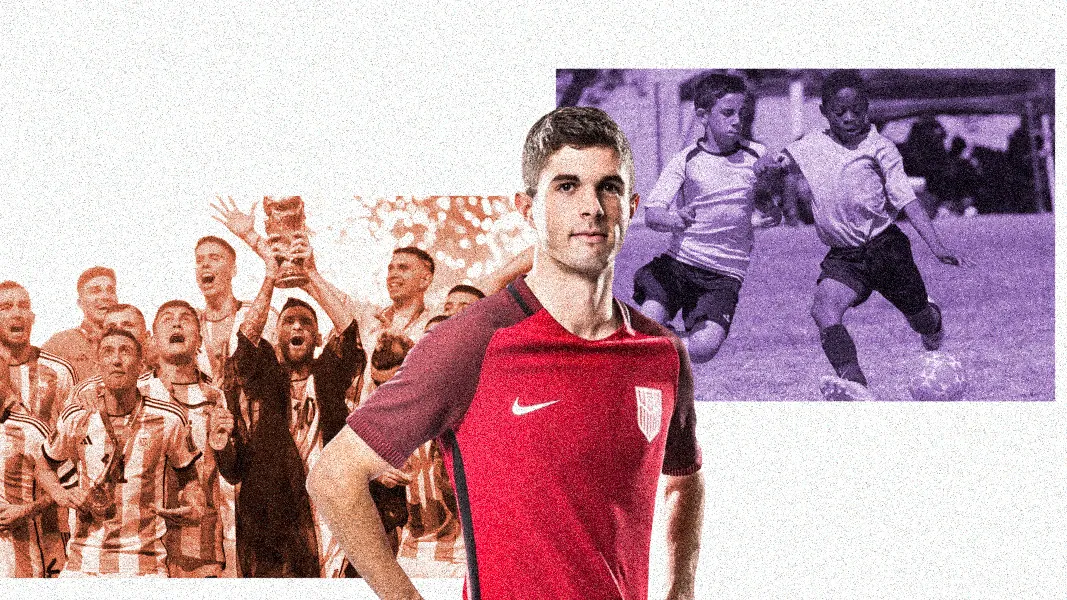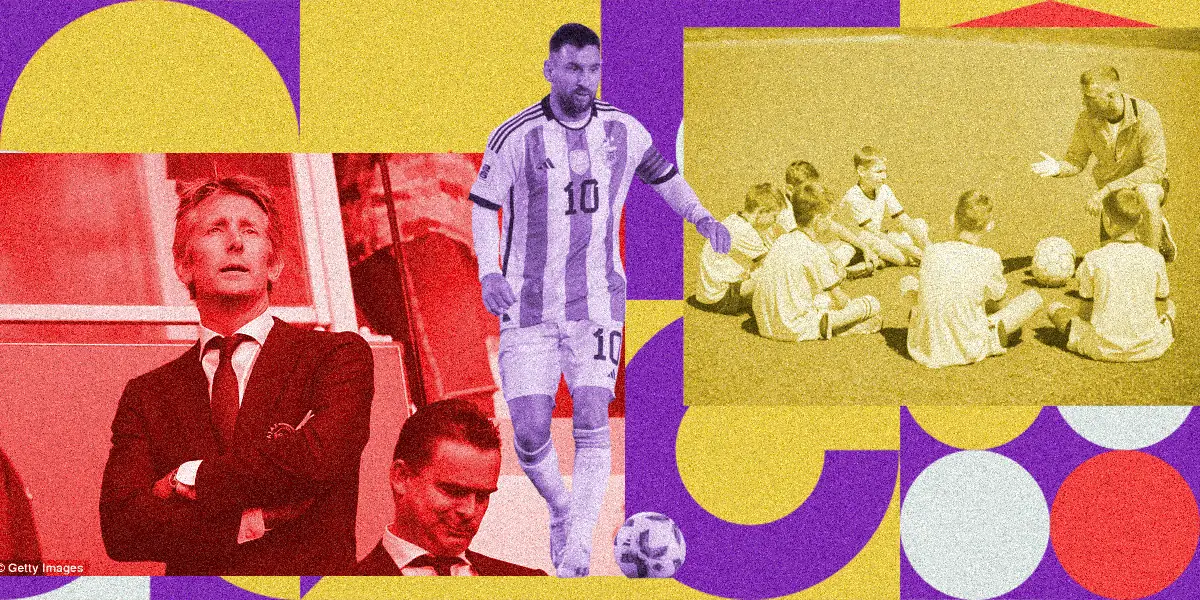Welcome to the ultimate guide to soccer formations! This guide consists of every known formation to exist in 11v11 soccer throughout its history. We will also briefly explain the formations along with illustrations.
Before getting into the list, let’s answer some common questions for beginners.
What are soccer formations and why are they important?
Soccer formations are the arrangement of players on the soccer field. They define the tactical shape and strategy of a team during a match. They also serve as blueprints guiding offensive and defensive maneuvers.
Offensive formations apply pressure on the opponent’s defense and help in creating goal-scoring opportunities. On the other hand, defensive formations aim to thwart attacks and create openings for counterattacks.
How do coaches select a formation?
Well, there are a lot of factors at play. Coaches can choose formations based on their team’s capabilities, match context, and available personnel.
Players also play a very important role in the success of a formation. They need to grasp their designated roles within the formation to execute strategies effectively.
Here are a few points on why formations in soccer are so important!
- Formations offer structure. This helps in fostering organization and strategy execution on the field.
- Moreover, formations enable teams to leverage their strengths and cancel out opponent advantages.
- By aligning players in a formation strategically, teams can dictate the flow of play and optimize efficiency.
So, whether you’re emphasizing defense, attack, or midfield control, soccer formations contribute significantly to a team’s performance and success on the pitch.
With the basics out of the way, let’s now look at the complete list of 11v11 soccer formations. By the end of this article, you’ll be a step closer to becoming a soccer tactics mastermind! So, let’s get started!
Famous Historical Soccer Formations
2-3-5 (The Pyramid)

The 2-3-5 formation is one of the oldest formations to be officially recorded in soccer. It originated around 1880, and marked a pioneering success in soccer tactics. This formation was known as ‘the Pyramid’ due to its triangular shape.
The 2-3-5 formation quickly became the standard in England and gained global popularity, remaining prevalent until the 1930s.
It consists of two Fullbacks, three halfbacks, and five forwards (2 wingers, 2 inside forwards, and 1 center forward).
The Pyramid was so common due to the unique strategic advantage it offered at the time. Its basic structure allowed for expansive attacks, utilizing width effectively while also maintaining a defensive posture against central counterattacks. As possession shifted to the defensive third, the halfbacks seamlessly joined the full-backs, ensuring numerical superiority against the opponent’s forwards.
The 2-3-5 has seen a resurgence in recent decades, being used by teams like Barcelona and AC Milan.
Danubian Variation of 2-3-5

The adaptation of the 2-3-5 by the Hungarian and Austrian national teams was so successful that it earned its own name, ‘The Danubian School’ Pyramid. The formation was mostly the same as the original Pyramid except the center forward played in a more withdrawn role.
This made the center forward of both the attacking play and transitional play in the midfield. Rather than long and direct play, the Danubian School variation relied more on short passing and skillful play.
2-3-2-3 (Metodo)

‘The Metodo’ formation was crafted by the brilliant Vittorio Pozzo, coach of the Italian national soccer team during the 1930s. This formation was a development of the Danubian school as Pozzo realized the need to fortify his midfield.
To achieve this, he strategically positioned two forwards just in front of the midfield, thus, enhancing defensive capabilities of the team compared to previous systems. This tactical shift not only bolstered the defense but also provided a foundation for effective counter-attacks.
The Metodo, with its versatile structure, has found a modern echo in teams. Pep Guardiola’s Barcelona and Bayern Munich are the most famous examples.
3-2-2-3 (WM)

The next big development came when teams started playing three at the back instead of two. We can thank the brilliant mind of Herbert Chapman from Arsenal for coming up with the revolutionary 3-2-2-3 formation.
The 3-2-2-3, or WM, came about as a response to the change in the offside law in 1925. The alteration reduced the number of opposition players required between attackers and the goal line from three to two. So, to counter this, Chapman introduced a third center-back to counter the opposing center-forward.
Now, what makes the WM a gem is its balance between defense and attack. It consists of three fullbacks, two half-backs, two inside forwards, and three forwards (2 wingers and 1 center forward). Because of its solidity in defense and fluidity in attack, the WM became highly prevalent in English soccer during the 1930s.
Notably, Patrick Vieira, a former Arsenal player, reintroduced the formation in 2016 with New York City FC.
3-2-3-2 (WW)

Next up is the 3-2-3-2 formation, also known as the WW (or MM if you flip the pitch). This twist on the WM formation was developed by the Hungarian mastermind Márton Bukovi.
Essentially, Bukovi flipped the forward line M from the WM formation into a W. And we had ourselves a highly exciting new formation.
Structurally, it comprises three fullbacks, two halfbacks (central midfielders), one attacking midfielder, two wide midfielders, and two forwards.
This formation introduces a dynamic element to attacking play, offering notable fluidity. The forwards have the flexibility to drop back, while the attacking midfielder exploits opportunities from a deeper position.
The WW has also found recent application, notably employed by Barcelona under the management of Xavi.
3-3-4

The 3-3-4 formation is one of the more unusual soccer formations. It gained prominence primarily during the 1950s and early 60s, especially in England.
Drawing parallels to the WW formation, the 3-3-4 formation’s distinguishing factor lies in the positioning of the center forwards. As opposed to the WW, the center forwards in the 3-3-4 maintain an advanced role, while the attacking midfielder operates from a deeper position.
Tottenham Hotspur notably brought the 3-3-4 formation to the limelight when they secured the double in 1961.
In modern soccer, it has become more of an end-game formation when your team needs a goal or two in the dying moments of the game.
4-2-4

The 4-2-4 formation is a blend of offensive strength and defensive solidity with a compromise on midfield control. It emerged as a response to the perceived rigidity of the WM formation. The 4-2-4 was also the first instance of a formation being designated by numerical representation rather than a descriptive name like ‘The Pyramid’ or ‘WM’.
The conceptualization of the 4-2-4 is attributed to Márton Bukovi, building upon the foundations of the WW formation. However, credit for its full development goes to Flávio Costa, the Brazilian national coach in the early 1950s, and Hungarian Béla Guttman.
Structured with four defenders, two midfielders, and four attackers, the 4-2-4 formation features a defensive line comprising a right-back, two center-backs, and a left-back.
Two central midfielders form a defensive double pivot. Their main focus is on screening, intercepting opposition attacks, and ball progression.
The attacking quartet includes two strikers centrally supported by wingers.
The 4-2-4 leverages the increasing skill and fitness levels of players. Its success relies on defenders who can not only defend but also contribute to building attacks, and midfielders who can cover both the attack and defense.
The 4-2-4 was most notably used by the Brazil team in their triumphant campaigns at the 1958 and 1970 World Cups.
1-6-3

The 1-6-3 formation is an all-out attacking strategy that pushes the boundaries of conventional soccer formations. 1-6-3 is such an offensive formation that it came to be referred to as the ‘Kamikaze’ formation.
This audacious formation comprises just one defender, accompanied by four central midfielders, two wide midfielders, two wingers, and one center forward.
The origins of the 1-6-3 formation date back to 1936 when Japan first deployed this unorthodox tactic. It had a successful debut at the 1936 Olympics when Japan caused a huge upset by defeating Sweden 3-2. However, the vulnerabilities of such an attacking-oriented strategy were quickly exposed when they suffered an 8-0 defeat to Italy in the next game.
Notably, the formation resurfaced in later years when Walter Bahr, the legendary United States player, occasionally employed it as the coach of the Philadelphia Spartans. The formation can still be seen on rare occasions in cup games when a team needs a goal towards the end of a game.
Popular Traditional Soccer Formations
4-4-2

When you think of classic soccer formations, the 4-4-2 is the first one that comes to mind. This formation was a staple of soccer in the 1990s and early 2000s as it epitomizes balance and structure on the field.
The 4-4-2 consists of four defenders, four midfielders, and two forwards. You need to have a versatile and hard-working team to pull off the 4-4-2 successfully.
The defensive line comprises two center-backs flanked by two fullbacks, forming a solid base for the team.
In midfield, the 4-4-2 requires both central and wide midfielders to contribute defensively and offensively. One central midfielder often adopts an attacking role, supporting the forward pair with timely runs and creative play. Meanwhile, the other central midfielder assumes a holding role, providing cover for the defense and initiating transitions.
The wide midfielders play a dual role, pushing forward to support attacks while also tracking back to assist the fullbacks defensively.
AC Milan’s dominance in the early 1990s exemplified the effectiveness of the 4-4-2 formation as they won multiple European titles with this formation.
While the 4-4-2 fell out of favor in the late 2000s due to perceptions of being outdated, recent years have witnessed a tactical resurgence. Teams like Claudio Ranieri’s Leicester City, Diego Simeone’s Atlético Madrid, and Carlo Ancelotti’s Real Madrid have revitalized the 4-4-2 once again.
4-4-1-1 Variation

The 4-4-1-1 formation has the slightest variation from the 4-4-2. In this formation, one of the forwards drops a little deeper to play as the second striker.
This formation is the perfect setup if you have a combination of a physical striker and a more creative striker. The creative striker can play in the hole behind the physical striker, forming the perfect strike partnership up top.
Other than this, the 4-4-1-1 and 4-4-2 are basically the same.
4-1-2-1-2 (4-4-2 Diamond)

The 4-1-2-1-2 formation is a soccer tactic that puts a lot of focus on the center of the pitch. It can be looked at as a variation of the 4-4-2 formation (4-4-2 Diamond) since the structure is almost the same except lack of wide midfielders.
In a 4-4-2 Diamond, width is primarily provided by the full-backs pushing forward. The defensive midfielder often resembles a deep-lying playmaker and also plays a crucial role in maintaining discipline and safeguarding the back four during defensive phases.
The central attacking midfielder takes on the mantle of the creative force, orchestrating plays by distributing the ball wide to the full-backs or providing incisive through balls to the two strikers. When out of possession, the midfield four drops back to assist the defense.
The most successful example of the 4-1-2-1-2 formation was Carlo Ancelotti’s Milan, particularly in the 2003 UEFA Champions League campaign. In this iconic lineup, Andrea Pirlo operated as the deep-lying playmaker, orchestrating plays, while Kaka and Rui Costa assumed roles as attacking midfielders.
The formation was used until 2006 when the striker Andriy Shevchenko left Milan. The team adopted the ‘Christmas Tree’ formation after his departure.
4-1-3-2 Variation

In the 4-1-3-2 variation of the 4-1-2-1-2 formation, the major defensive responsibility in the midfield falls on the lone defensive midfielder. This tactical setup allows the three remaining midfielders to adopt a more advanced and aggressive position, creating a potent presence in the forward middle of the pitch.
The 4-1-3-2 is widely regarded as a highly attacking formation, leveraging the offensive capabilities of the midfield trio.
While the 4-1-3-2 excels in dominating the central areas, its potential shortcoming lies in the lack of width. Teams with speedy wingers and proficient passing abilities can exploit the wings before the offensive midfielders can retreat to support the defensive line.
Despite the shortcomings, the formation has seen success, notably with the England national team in the 1966 World Cup under Alf Ramsey.
Additionally, Valeriy Lobanovskiy employed this system at Dynamo Kyiv, securing three European trophies in the process.
4-3-3

Another evergreen classic formation is the 4-3-3. The 4-3-3 was a development of the 4-2-4 formation and was initially used by the Uruguay national team in the 1950 and 1954 World Cups. Brazil also embraced this setup during the 1962 World Cup.
This formation features four defenders, three central midfielders, two wingers, and a lone striker. It strategically deploys an additional player in the midfield, enhancing defensive solidity.
The 4-3-3 is also a versatile setup as it allows the midfield trio to adapt to various in-game scenarios and dynamically rotate roles. Coordinated movement and defensive protection characterize the midfield play, with the three players closely working together.
The 4-3-3 gained widespread recognition in club soccer through Johan Cruyff’s Ajax team in the 1970s, securing three European Cups.
In contemporary times, managers like Jose Mourinho (credited with introducing the formation to England) have successfully employed the 4-3-3. He was also the manager to introduce a specialist defensive midfielder to the formation, which later came to be known as the Makelele role.
The 4-3-3 was also used to great effect by Pep Guardiola during his time at Barcelona.
4-3-1-2 Variation

The 4-3-1-2 formation is a nuanced variation of the 4-3-3. It introduces a central attacking midfielder in lieu of one of the strikers. This adjustment places emphasis on the attacking midfielder orchestrating plays through the center, flanked by the strikers on either side. The result is a more compact and narrower setup compared to the traditional 4-3-3.
This tactical approach found success in the managerial strategies of renowned figures like Jose Mourinho, who deployed it during his tenure at Porto.
Carlo Ancelotti also embraced the 4-3-1-2 formation with Chelsea during the 2009/10 season.
Massimiliano Allegri achieved notable success with AC Milan in the 2010/11 season, clinching the title while employing the 4-3-1-2 formation.
4-3-2-1 (The Christmas Tree)

The 4-3-2-1 formation, aptly named “The Christmas Tree”, is one of the most intriguing formations in modern soccer. This formation features four defenders, three central midfielders, and two attacking midfielders positioned “in the hole” behind a lone striker. This structure makes the formation resemble a Christmas tree.
In this narrow formation, the three central midfielders play a pivotal role, acting as workhorses to cover for the creative talents of the attacking midfield duo. Due to its narrow structure, the reliance to provide width falls on the fullbacks.
The 4-3-2-1 was notably successful at Tottenham Hotspur under the management of Terry Venables and Christian Gross. However, ‘The Christmas Tree’ has lost popularity in England over time.
Despite its decline in England, the formation has maintained its Carlo Ancelotti occasionally utilized this formation during the 2007 Champions League-winning campaign.
4-2-2-2 (Magic Rectangle)

The 4-2-2-2 formation, affectionately known as the “magic rectangle” or “magic square,” has earned its reputation as a highly successful and famous tactical setup. It consists of four defenders, two defensive midfielders, two box-to-box midfielders, and two forwards.
The “Magic Rectangle” strategically combines two deep-lying forwards with two box-to-box midfielders to add a dynamic style of play in the middle of the pitch.
While celebrated for its success, the formation has faced criticism, with some labeling it as “deeply flawed” and “suicidal”.
Notable instances of its application include the French national team under Michel Hidalgo during the 1982 World Cup and Euro 1984.
The 4-2-2-2 was also used successfully by Manuel Pellegrini with Real Madrid, Villarreal, and Málaga.
4-5-1

The 4-5-1 formation is one of the most defensive formations in soccer. It’s essentially a modified 4-3-3 and features four defenders, three central midfielders, two wide midfielders, and a lone striker.
What distinguishes the 4-5-1 from 4-3-3 is the conservative role assigned to the two wide midfielders, contributing to a more defensive stance.
This formation is adept at grinding out 0–0 draws or preserving a lead. However, it can also be used to carry out deadly counterattacks.
The compact midfield, with three central midfielders working closely together, poses challenges for the opposition to build up play. Additionally, the closeness of the midfield often results in the opposing team’s forwards struggling to secure possession.
Because of the defensive structure, the responsibility falls on the lone striker to push forward and create goal-scoring opportunities. The defensive midfielder in the 4-5-1 often assumes a crucial role in controlling the pace of the game.
The 4-5-1 was often used by Sir Alex Ferguson during Manchester United’s fixtures in the UEFA Champions League.
3-5-2

From a defensive formation, we move on to an attacking one. The 3-5-2 formation is similar to the 5-3-2 but with notable attacking differences. It deploys three center-backs, one defensive midfielder, two attacking midfielders, two wing-backs, and two forwards.
One of the main distinctions between the 3-5-2 and the 5-3-2 is the absence of a sweeper or libero. The 3-5-2 has three classic center-backs. Another important difference is the role of the wing-backs who play a more offensive role than in a conservative 5-3-2.
In this formation, the central midfielder often remains deeper to assist in preventing counter-attacks.
The 3-5-2 first gained prominence under Carlos Bilardo, who led Argentina to victory in the 1986 World Cup.
Since then, it has been widely embraced in Italy. The 3-5-2 has been employed by successful managers like Gian Piero Gasperini during his time at Genoa CFC and Atalanta, as well as Antonio Conte, who secured three consecutive Serie A titles with Juventus and later with Chelsea.
A modern interpretation of the 3-5-2 has been innovatively utilized by Simone Inzaghi at Inter, emphasizing ball possession through the involvement of goalkeepers and central defenders in the build-up play.
5-3-2

The 5-3-2 formation is characterized by three central defenders, one of whom takes up the role of a sweeper, and the two wing-backs.
In this setup, the traditional winger and full-back positions blend into the wing-back role. In fact, the wing-backs in a 5-3-2 have the most demanding role as they are responsible for covering their flank along the entire pitch.
The rest of the lineup is very similar to the structure of a 3-5-2 formation.
Notably, the 5-3-2 gained prominence at the club level under the management of Helenio Herrera with Inter Milan. He was also the inventor of the sweeper or libero role in soccer.
On the international stage, the Brazil national team used the 5-3-2 formation during their 2002 World Cup win. The formation worked perfectly with the players they had, especially with their iconic wing-backs Cafu and Roberto Carlos.
1-4-3-2 Variation (with a Deep-Lying Sweeper)

The 1-4-3-2 variation is a tactical twist on the 5-3-2 formation, introducing a more withdrawn sweeper into the defensive structure. In this setup, the sweeper has the flexibility to join the midfield and advance alongside the full-backs. The more dynamic role of the sweeper helps in adding an extra layer of versatility to the formation.
One of the most notable instances of the 1-4-3-2 variation in action was the West Germany team under Franz Beckenbauer at the 1990 World Cup.
Modern Soccer Formations
4-2-3-1

The 4-2-3-1 formation is arguably the most common tactical setup in modern soccer as it strikes a perfect balance between offensive and defensive plays.
The 4-2-3-1 features four defenders, two holding midfielders, one attacking midfielder, two wingers, and a lone forward. Notably, both the wide players and the full-backs have the freedom to engage in attacking plays.
In defense, the 4-2-3-1 takes up the shape of either the 4–5–1 or 4–4–1–1 soccer formations. The packed midfield of this formation is effective in maintaining ball possession and thwarting opponent attacks by controlling the midfield area.
The lone striker in this formation also plays a pivotal role and requires strength to hold the ball as midfielders and full-backs join the attack. The attacking midfielder strategically occupies the space behind the striker which is left empty by defenders tracking the striker and wingers.
The 4-2-3-1 is highly praised for its versatility at the top of the field as the front four often switch their positions between each other.
It has been adopted by national teams like Belgium, France, the Netherlands, and Germany in an asymmetric shape.
This formation has found extensive use across the globe, with notable examples such as Liverpool under Rafael Benítez. Liverpool’s 4-2-3-1 featured Javier Mascherano, Xabi Alonso, and Steven Gerrard in the middle of the field. Gerrard played behind the striker Fernando Torres, while Mascherano and Alonso took a deeper role.
4-2-3-1 was also used by Bayern Munich under Jupp Heynckes during their treble-winning 2012–13 season.
4-2-1-3

The 4-2-1-3 formation is an unconventional yet strategically potent tactical setup. It was developed by José Mourinho during his tenure at Inter Milan. The 4-2-1-3 consists of four defenders, two holding midfielders, one attacking midfielder, two wingers, and a lone striker.
This formation emphasizes the creation of small, cohesive units across the pitch, each operating in specific roles. A distinctive feature is the segmentation into defending, middle, and attacking thirds, allowing the team to outnumber the opposition in all areas.
The primary objective of the 4-2-1-3 is to maintain numerical superiority across the field while conserving player energy. This approach prevents exhaustive exertion on all team members.
Mourinho notably achieved remarkable success with this formation, securing a treble in only his second season at Inter Milan. this system, the holding midfield positions were crucial, with captain Javier Zanetti and Esteban Cambiasso providing defensive stability, allowing more players to engage in attacking plays.
Wesley Sneijder operated in the attacking midfield role, and the front three functioned as a cohesive unit of strikers rather than a traditional distribution with a central striker and wingers.
4-6-0 (False Nine)

The unconventional 4-6-0 formation is a tactical evolution from the traditional 4–2–3–1 or 4–3–3 setups. The main caveat of this setup is the substitution of the center forward for a player adept at the trequartista role, commonly referred to as the ‘False Nine’.
This innovative approach gained prominence due to its potential to reshape the dynamics of soccer tactics and was seen as the future of the sport.
In this formation, the absence of a conventional striker is compensated by the strategic advantage of deploying a mobile front four. The False Nine concept challenges opposing defenders to mark the front four without compromising their positions.
However, the success of this formation relies heavily on the intelligence and pace of the attacking quartet in exploiting spaces left by the opposition. That’s why only a few teams have embraced the 4-6-0 formation on a regular basis.
Anghel Iordănescu’s Romania was one of the first teams to use the 4-6-0 formation in the 1994 World Cup. They secured a memorable victory against Argentina in the Round of 16 using this formation.
Another successful implementation was seen in Luciano Spalletti’s Roma side in the 2005–06 Serie A season. Subsequently, Sir Alex Ferguson’s Manchester United experimented with the 4-6-0 during their successful 2007/08 campaign.
Other than that, the Spanish team used a False Nine tactic in the Euro 2012, Pep Guardiola used it before the arrival of Erling Haaland at Manchester City, and Mikel Arteta still uses it at Arsenal.
3-4-3

The 3-4-3 formation is a high-risk-high-reward strategy. It consists of three center-backs, two wing-backs, two central midfielders, two wingers, and a lone striker.
This setup creates a dynamic and flexible structure that allows for both offensive and defensive contributions from various positions on the field.
In the 3-4-3, the midfielders play a pivotal role as they are expected to alternate between supporting attacks and also providing defensive coverage.
The decision to have only three dedicated defenders, however, exposes the team to potential defensive vulnerabilities, making it easier for the opposition to breach and score.
Despite this defensive risk, the 3-4-3 formation shines in its offensive capabilities, with three forwards concentrated on creating scoring opportunities. This setup is often favored by more attack-minded teams seeking to dominate matches and impose their style of play on the opposition.
Famously, Liverpool used the 3-4-3 formation during the second half of the 2005 UEFA Champions League Final. This tactical adjustment played a crucial role in their comeback from a three-goal deficit.
Contemporary managers like Antonio Conte and Thomas Tuchel have also employed the 3-4-3 formation at Chelsea during the attacking phases of matches.
3-2-4-1

The 3-2-4-1 formation is among the newest tactical innovations in soccer. It has gained prominence under the management of Pep Guardiola at Manchester City.
This setup features three center-backs, two holding midfielders, two wingers, two attacking midfielders, and a lone striker. The 3-2-4-1 provides a balanced structure for both offensive and defensive phases of play.
However, the 3-2-4-1 is not a starting formation (as formations are becoming more flexible as more advanced tactics come into soccer). It starts as a conventional 4-2-3-1 and undergoes a transformation during attacking plays.
One of the center-backs or fullbacks seamlessly transitions into the holding midfield position and becomes a part of the team’s build-up play. Simultaneously, one of the defensive midfielders advances further up the pitch, creating a dynamic and fluid offensive midfield quartet.
This tactical shift has proven to be highly effective as it helped Manchester City to win the continental treble in the 2023/24 season.
3-4-1-2

The 3-4-1-2 formation is a tactical evolution which draws inspiration from both the 3–5–2 and 3-4-3 setups. In this arrangement, the traditional wingers are withdrawn, making room for one of the central midfielders to advance into the “number 10” playmaker position.
This adjustment makes the team take a more centralized and creative attacking approach.
Critical to the success of the 3-4-1-2 is the role of wing-backs with exceptional stamina, as they are required to cover significant ground. The formation also demands the presence of a standout playmaker in the attacking midfield position; someone capable of orchestrating plays and unlocking opposition defenses.
3-4-1-2 is known for its effectiveness in counter-attacking soccer. However, teams can face challenges when encountering opposition utilizing a conventional back four and pushing their fullbacks forward to support wingers. The wingbacks in this formation often comes under intense pressure, requiring central midfielders to provide cover on the flanks.
Apart from providing cover, the central midfielders also play a dual role, acting as both ball-winners and deep-lying playmakers.
Jorge Sampaoli used the 3-4-1-2 with Chile to defeat Spain at the 2014 World Cup. The formation was also seen with Brazil at the 2002 World Cup during the attacking phases of the game.
3-6-1

The 3-6-1 formation is a unique and uncommon modern tactical approach, which focuses on ball possession in the midfield. It is relatively rare to witness this formation as an initial setup, as its strategic use becomes more apparent in situations where a team wants to maintain a lead or secure a tie.
It comprises a back three, two wing-backs, two defensive midfielders, two attacking midfielders, and a lone striker. The lone forward in this formation plays a crucial role, requiring not only goal-scoring prowess but also tactical acumen. Beyond scoring, the striker becomes instrumental in creating goal-scoring opportunities by including teammates into the attacking play.
When a team playing with 3-6-1 is leading the game, there is a heightened emphasis on ball control, short passes, and strategically running down the clock.
Conversely, if the team is trailing, adjustments may include positioning one of the attacking midfielders closer to the edge of the area to add depth to the attack.
Only a few coaches have used this formation on the big stage. Steve Sampson was one of them when he used the 3-6-1 formation with United States at the 1998 World Cup.
Guus Hiddink also used the formation effectively at the 2006 World Cup with Australia.
3-3-1-3

The 3-3-1-3 formation is an extremely attacking tactical setup, originating as a modification to the Dutch 4–3–3 system developed by Ajax. Visionary coaches like Louis van Gaal and Johan Cruyff took this system to new attacking extremes, and it eventually found its way to Barcelona.
At Barcelona, it influenced players such as Andrés Iniesta and Xavi who were molded into the philosophy of 3–3–1–3.
This formation comprises three center-backs, one defensive midfielder, two box-to-box midfielders, one attacking midfielder, two wingers, and one striker. Due to the lack of width, the 3-3-1-3 requires intense pressing high up the pitch, particularly from the forwards. It also requires an extremely high defensive line. You have to basically play the entire game within the opponent’s half.
The tactical approach of 3-3-1-3 further demands precision in technical abilities and rapid ball circulation. The slightest mistake or dispossession can expose the team to vulnerable counter-attack situations.
Cruyff’s variant featured a flatter and wider midfield, while Van Gaal opted for an offensive midfielder and a midfield diamond to enhance the link-up with the front three.
Marcelo Bielsa, known for his innovative tactics, has also implemented the 3-3-1-3 system with success for Argentina and Chile’s national teams. Currently, he remains one of the few high-profile managers to utilize this formation in competitive play.
3-3-3-1

The 3-3-3-1 formation can be seen as a very close relative of the 3-3-1-3. Similar to the 3-3-1-3, the 3-3-3-1 formation is a very attacking tactical setup that remains relatively rare in modern soccer. Its compact nature makes it ideally suited for midfield domination and ball possession.
In this formation, the two wingers drop a bit further back to join the midfield and increase the numbers in the middle of the pitch. Coaches often opt for the 3-3-3-1 when aiming to field more attacking players and reinforce the spine of the team.
The attacking trio typically involves two wing-backs or wingers flanking the central player, who assumes a central attacking midfield or second striker role behind the center forward.
The midfield three in the 3-3-3-1 formation is composed of either two center midfielders ahead of a central defensive midfielder or one central midfielder alongside two defensive midfielders.
Defensively, the three at the back can consist of either three center-backs or one center-back paired with a full-back on either side.
The tactical genius that he is, Marcelo Bielsa was the biggest contributor to the 3-3-3-1 formation. He notably used the formation with Chile in the 2010 World Cup.
Barcelona also used the 3-3-3-1 in the historic 6-1 victory against PSG towards the end of the game.
5-4-1

The 5-4-1 formation is renowned for its defensive nature and emphasizes solidity at the back. This setup features an isolated forward and a densely packed defense, making it challenging for opponents to break through.
With three center-backs forming the defensive core, the team further bolsters its resilience with two defense-minded wingbacks. In the midfield, there are two central midfielders complemented by two wide midfielders.
Interestingly, the formation’s dynamics can shift based on the role of the wingbacks. If they adopt an attacking stance, the formation takes on characteristics of a 3-6-1.
One of the most iconic instances of the 5-4-1’s success was witnessed in the Euro 2004, where the Greek national team won the tournament with this formation. This victory solidified the 5-4-1’s reputation as a formation capable of achieving success, especially with underdog teams.
Thank You For Reading
At the end of the day, the best formation for you depends on the strengths of your players and the philosophy you want to implement in your soccer team. Starting with a specific formation doesn’t mean that your team will end the game with the same formation either. Soccer is all about adapting to the game and making the right choices at the right time.
I hope you enjoyed our comprehensive guide on all the famous soccer formations. If you did, then do consider sharing it with fellow soccer enthusiasts.
Your support and sharing of this content can help us reach a wider audience and provide valuable information to more people who share our passion for the beautiful game.
Did we leave out any good formations? Do you want us to make more tactical-based content? Let us know in the comments below.
Thank you for supporting Soccer Mavericks!
If you liked this article, you will love reading:
- Best Attacking Formations in Soccer (4-2-4, 4-3-3, 3-4-3…)
- Best Defensive Soccer Formations (5-3-2, 4-5-1, 4-4-2…)
- 7v7 Soccer Formations: Comprehensive Guide [with PDF]
- What Are the Soccer Positions Called? A Comprehensive Guide
- What Position Is CDM in Soccer: Position Explained
- What is the Hardest Position in Soccer? (Top 6 Explained)












